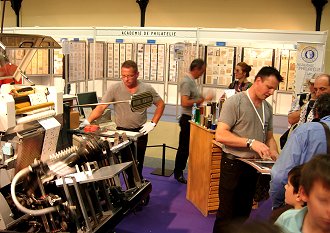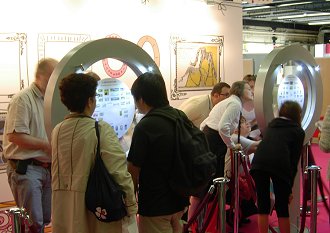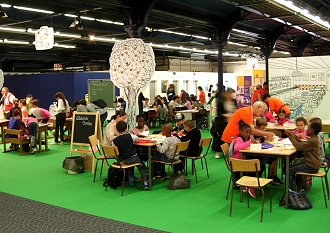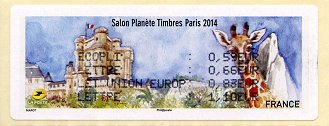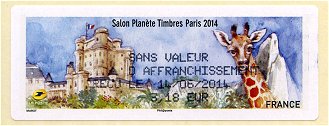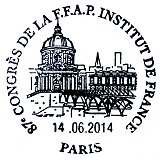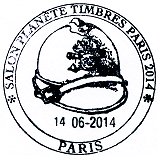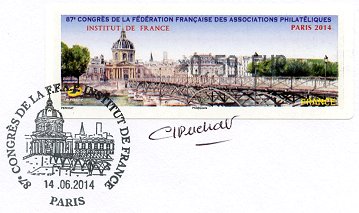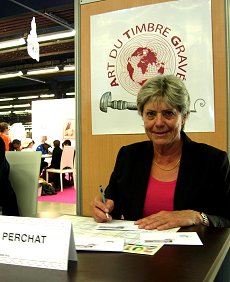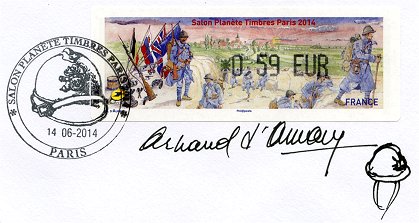| FRANCE. The SALON PLANÈTE TIMBRES PARIS 2014 |
In 2014,
the great biennial event of French philately, the Salon Planète Timbres, was held at its usual location - the Paris Parc Floral, from Saturday14th to Sunday 22nd June.
 |
On its sixth anniversary, this major philatelic venue will be remembered with a certain bittersweet taste, because, quite possibly, it did not achieve 50% of the more than 100,000 expected visitors.
Since its start in 2004 with about 85,000 visitors, the show has been attracting increasing numbers, reaching close to 120,000 visitors in recent times. But dropping from this figure to possibly less than 50,000 (about 10,000 were school visits) is something that significantly worries the philatelic world, especially La Poste who, through Phil@poste, made a huge financial and organizational effort to offer one of the best international philatelic events.
The favourite topic of conversation amongst all present, and one of the main reasons for this concern, seemed to be the strike of the French railwaymen during the earliest days of the show, making it difficult to access the show, for those coming from outside Paris. |
| Although the organizers arranged a good advertising campaign, with panels on Paris buses and subway stations, the budget of the philatelic event was much less than the 3½ - 4 million euros of previous events, and this was noticeable throughout the exhibition hall. |
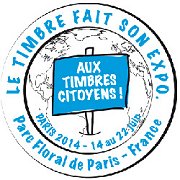 |
(See also the articles devoted to the Salon du Timbre 2006 >, 2008 >, 2010 >, & 2012 >, also published in VARIABLE 1, 9, 17 & 25).
Much more worrying is the growing disinterest in philately, and the increasingly critical attitude of lifelong collectors, because of the avalanche of new issues (totalling about 200 EUR, that were on sale during the show), plus the current economic crisis.
We now look forward to the next Salon Philatélique d'Automne, to be held in November, to see if this drop was just a blip, or if we are facing a clear trend of deep concern in French philately. |
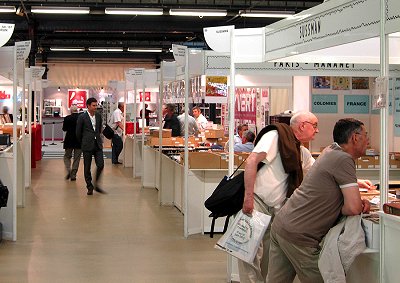 |
 |
| Overview of the Planète Timbres 2014 show, with demonstrations of the French stamp printing company -l'Imprimerie de Phil@poste- in the foreground, and the philatelic dealers stands at the bottom |
The 2014 show was developed for the nine days under the motto 'Aux timbres citoyens !', and was set out as a miniaturised version of the city in which the streets and major landmarks were recreated within the show area. As on previous occasions, the event included three major sectors - (1) the commercial, with the large Phil@poste stands and about 70 more for the international philatelic dealers, (2) the exhibition area, with the French championship of philately and the international philatelic competition, and (3) an activity zone divided into 10 areas, invaded during the week by school groups, where the organization and its partners prepared workshops, demonstrations, performances, competitions, conferences, exhibitions, ... some of them having little or nothing related to philately and/or the postal world.
As usual, the organization offered various stands to major national philatelic associations and institutions.
Comparing the figures from the previous event in 2012, we can see the falling away of the philatelic event, with less dealer stands, less scheduled activities, and with only 3 or 4 international postal administrations and a few others represented by one large commercial company. Indeed, the decrease in contents was perfectly visible from the entrance hall, with a large space of over 1,000 m² mostly empty, and occupied only in a small corner for a non-philatelic activity organized by the Red Cross.
Each day Phil@poste released new philatelic products -stamps, sheets, booklets, collector packs ..., each with its own special or first day postmark.
Among these, a controversial special edition - the first issue of 'Les Trésors de la philatélie', a series that will last for 5 years. Each year, Phil@poste will publish a folder consisting of 10 sheets with 5 stamps, reproducing historical French stamps. The face value of the stamps included in the first folder is ... 120 Euros ! |
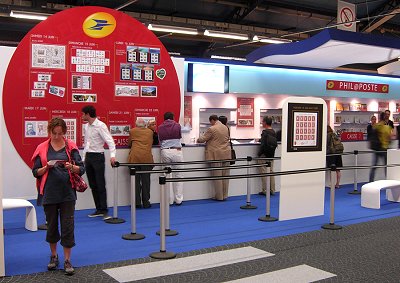 |
In addition, and directly related to our area of study, were 3 new issues of vignettes LISA.
For the first time, all the LISA designs are related to philatelic issues for sale during the show.
| The first commemorates the 87th congress of the Fédération française des associations philatéliques, held on June 21st, in the venue’s premises. The vignette LISA is illustrated with |
a gorgeous design of the Pont des Arts and the Institut de France, in Paris (see also the front cover of VARIABLE 33). The design is by Claude Perchat, author of some other LISA releases, from a photograph of S. Vielle, by Phil@poste.
On June 21st, Phil@poste also released a 'traditional' stamp with commemorative vignette dedicated to the conference, and was designed by Claude Andréotto (right image). |
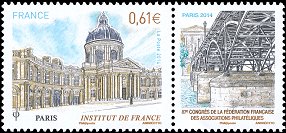 |
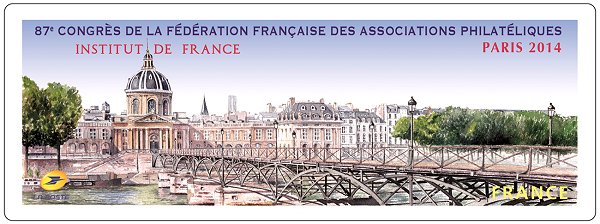 |
| The second LISA design is by Geneviève Marot, a little-known designer in the philatelic world, the author of a stamps booklet for Phil@poste. The composition is dedicated to the Paris Parc Floral, with the image of two locations near the park - the Château de Vincennes, with its donjon, and the Paris zoo, with a giraffe and the grand rocher -the huge fake boulder, the symbol of the park. |
| As in the previous case, Phil@poste also released an stamp dedicated to Parc zoologique de Paris, designed by Éric Viennot, to mark the 80th anniversary of its creation, and the reopening of the park after 6 years of renovations. |
 |
 |
The third issue is dedicated to one of 2014’s favourite topics, the centenary of the start of the 'Grande Guerre', the First World War. The design is by Arnaud d'Aunay, a self declared 'peintre voyageur' or traveller painter. He also designed, in 2013, the 'Capitales européennes' souvenir sheet dedicated to the Madrid.
During 2014, Phil@poste released various commemorative editions for this important anniversary. Among them, the stamps collector1914-1918 with 5 self-adhesive stamps (right).
The images below show 3 phases of the preparatory designs for the vignette LISA. Looking at the first design, which is a bit dramatic, it shows the destroyed city after a bombing whilst at the bottom part is a devastated landscape, a wounded soldier in the trenches being transported on a stretcher, and the French soldier or poilu at the right foreground, carrying a rifle.
In the second design, it is possible to read some of the comments made to the artist (...), which led him to introduce significant changes to the initial design - 'Pas de blessés' (no injured people), 'Paysage avant la destruction' (landscape before the destruction ), 'lever de soleil' (dawn), 'Village avant bombardement' (village before the bombing), 'atmosphère + sereine' (more serene atmosphere).
The final design he takes all these comments into consideration, with a quiet serene landscape, and soldiers waiting quietly in the trench. Even the soldier on the right, has changed his rifle for a cane ! |
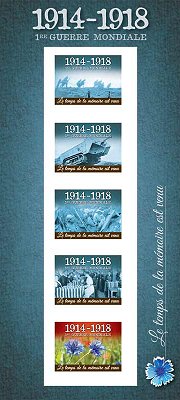 |
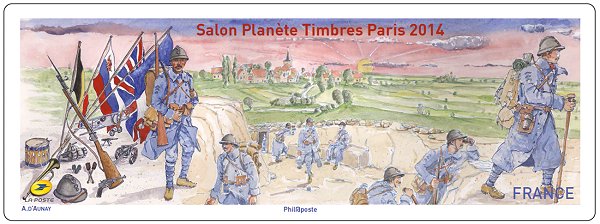 |
As is usual with the major philatelic events held in Paris from 2012, all the LISA designs were available from the 2 types of distributors used by Phil@poste – those issued by Monétel LISA 1 machines, using mechanical/ink printing, and those from the IER LISA 2 postal kiosks, which use thermal printing.
 |
For the first two designs, Phil@poste produced 30,000 self-adhesive labels on normal / plain paper, and 40,000 for the design dedicated to World War I. In addition, for each design, they produced another 30,000 labels on thermal paper, for use in the IER equipment.
All the labels are printed by offset, and there are no differences in the design, or the format, only in the type of paper used. The last two designs were manufactured by one printing company, possibly l'Imprimerie de Phil@poste, and the design dedicated to the 87th congress by another printing company, which Phil@poste sometimes diverts some printing work.
Phil@poste installed six distributors, three Monétel machines and three IER postal kiosks (moved temporarily from the Paris Louvre post office), at the opposite end of the show entrances. The decrease in the number of visitors was especially visible in this area, where, except for very specific periods, there were no long queues as on previous occasions. |
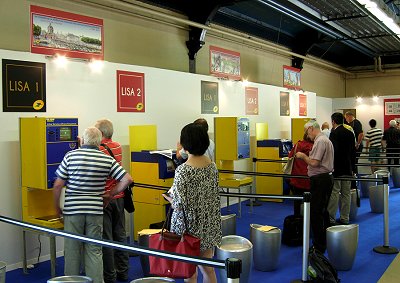 |
| Monétel LISA 1 - Normal paper and ink printing |
IER LISA 2 - Thermal paper and printing |
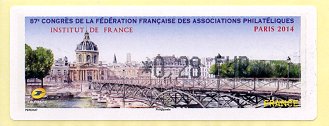 |
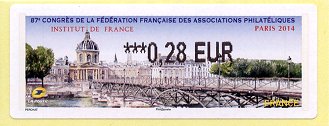 |
 |
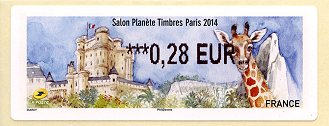 |
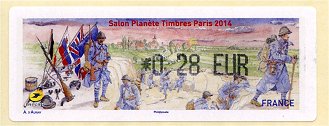 |
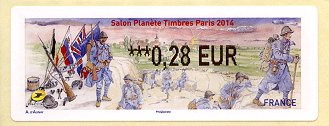 |
For ATMs issued by Monétel LISA 1 distributors, considering the programmed prefixes and current postal rates, the basic set could be made up of 4 values - E 0,59 EUR - 0,66 EUR - P 0,83 EUR - LETTRE 1,10 EUR, corresponding to the basic rates for economic domestic mail (E - Ecopli), priority domestic mail (without prefix), priority international mail (P), and priority domestic mail for letters above 20 g. (LETTRE). These machines can also provide purchase receipts showing the ATMs issued, and were printed on the same self-adhesive labels as those used for the stamps.
| The minimum face value programmed in ALL the machines was 0.28 EUR (upper images), a really strange value established by Phil@Poste, corresponding to the 'first franking complement', (or make-up rate) for the difference between the current postage rates for domestic economic mail (Ecopli) for letters up to 20 g. (0.59 EUR) and those up to 50 g. (0.87 EUR). |
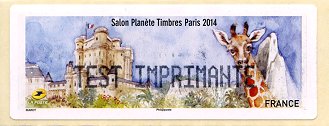 |
| Label - TEST imprint |
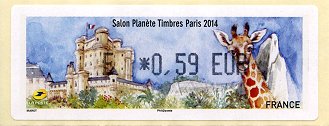 |
 |
| E - Inland post Economique / Ecopli |
Inland post Prioritaire |
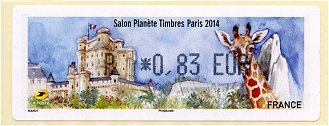 |
 |
| P - International Priority mail - Prioritaire |
LETTRE - Inland letters above 20 g. |
| Receipts in French for the purchase of the 4-values set, with the list of stamps issued and the total paid |
| For ATMs issued by IER LISA 2 postal kiosks, according to the tariff program in the machines installed in the show, it was possible to obtain ATMs of the 3 designs with up to 40 different indicators - the 20 shipment types plus the corresponding 20 franking complements, as well as ATMs with no text, just the face value. |
 |
| Label - TEST imprint |
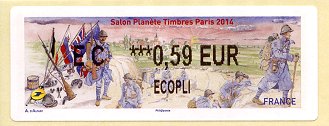 |
 |
| Inland economic mail - EC ECOPLI |
Inland priority mail (J+2) - LV LETTRE VERTE |
 |
 |
| Inland priority mail (J+1) - LP LETTRE PRIORITAIRE |
International priority mail
IP LETTRE PRIORITAIRE INTERNATIONALE |
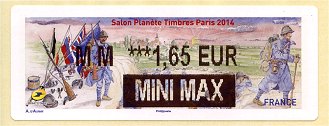 |
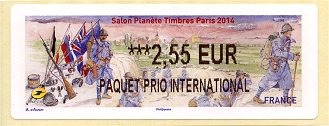 |
Inland priority mail - Small parcel
MM MINI MAX |
International priority mail - Small parcel
PAQUET PRIO INTERNATIONAL |
In addition to the first day postmarks for the different stamp issues, Phil@poste also prepared general dated postmarks for the Salon Planète Timbres, and one variable date special postmark for each vignette LISA(images below).
Postmarks are illustrated with (1) a picture of the Pont des Arts and the Institut de France, (2) a floral motif, and (3) an Adrian helmet, the steel combat helmet used by the French army during World War I, first worn in 1915. |
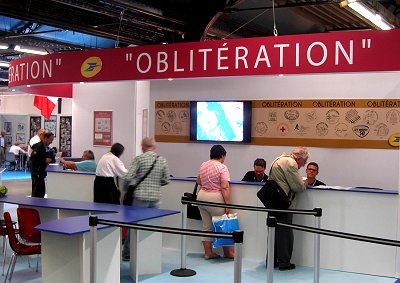 |
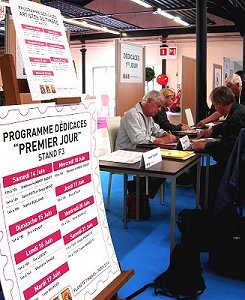 |
Phil@poste and the association L'art du timbre gravé organized daily signing sessions with the stamps designers. Claude Perchat and Arnaud d'Aunay, designers of two of the LISA issues, participated in these sessions (images below). It was a great opportunity to meet the designers and talk about these small artworks. |
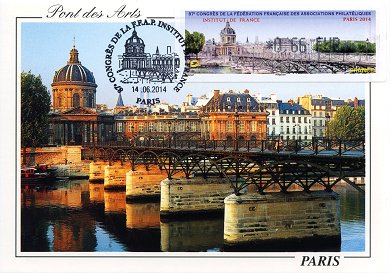 |
Maximum cards 'Institut de France', with the special pictorial postmark, dated on the first day of issue - June 14th. |
 |
 |
Maximum cards with the 'Parc Floral' issue, produced using commercial postcards showing the two main motifs depicted in the composition - the Paris zoo, with giraffes and the grand rocher, and the Château de Vincennes. The maximum card below is postmarked at the Vincennes main post office, located near the castle. |
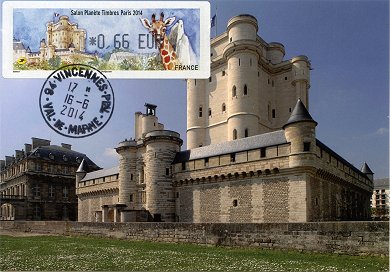 |
 |
Maximum cards 'La Grande Guerre', produced using original vintage postcards showing a poilu or French soldier, with all his equipment, and a group of soldiers prepared for battle. All soldiers carry the Adrian helmet, which also appears in the commemorative postmark.
During World War I, the French soldiers were known by the name of poilus. This word could be translated as hairy. About 1,400,000 poilus were killed during the four years of war. |
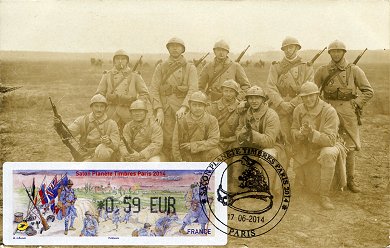 |
ATM Web - Spain and Latin American Postal Services: http://www.ateeme.net
© J. Jove - ATEEME. Variable value stamps study group. All rights reserved
This page was created in July 2014 and last updated:
20.07.14
. English edition rewritten by S. Goodman (20.07.2014)
|




